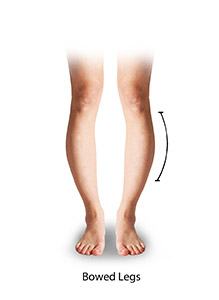
Bowed leg is a bony deformity resulting in outward curvature of one or both knees of the lower legs. It is commonly seen in toddlers and overweight adolescents.
Children under 2 years of age may present with bowed legs (physiologic), which usually corrects itself by the age of 3 to 4. Bowed legs may be associated with Blount’s disease (an abnormality of growth plates present at the ends of long bones) and rickets (bone disease due to deficiency of vitamin D, calcium and phosphorus).
Symptoms of Bowed Legs
It is more noticeable while standing and walking with the feet together where an obvious space is noticed between the knees. In toddlers with bowed legs, the development of walking is not delayed and coordination is normal, but the gait is awkward. Bowed legs are usually painless but may cause ankle, hip and knee discomfort by adolescents due to the pressure applied on these joints. It may be associated with intoeing (inward curvature of the forefoot) and frequent tripping.
Treatment of Bowed Legs
When your child presents with the above symptoms, your child’s doctor will perform a thorough physical examination. Symmetric bowing before the age of 2 does not require further testing. If bowing is more prominent on one leg or your child is older than 2-1/2 years, your doctor will order X-ray and blood tests to identify Blount’s disease or rickets.
Physiologic bowed legs do not require treatment, but your doctor may want to examine your child every 6 months to follow its progress. Early Blount’s disease may be treated with braces. Medications and orthopedic treatment are necessary to control rickets. Surgery is recommended to correct persistent bowed legs resistant to conservative management. It involves altering the growth plates or cutting and realigning the shin bone near the knee to correct the alignment. Following surgery, physical therapy is usually recommended to improve strength and range of motion.
Related Topics
- Patellar Instability
- Multiligament Instability
- Patellofemoral Instability
- Posterolateral Instability
- Knee Arthritis
- Knee Osteoarthritis
- Knee Injury
- Knee Pain
- Anterior Knee Pain
- Meniscal Tears
- Runners Knee
- Jumpers Knee
- Unstable Knee
- Knee Sprain
- MCL Sprains
- ACL Tears
- MCL Tears
- Meniscal Injuries
- PCL Injuries
- Ligament Injuries
- Knee Fracture
- Fractures of the Tibia
- Patella Fracture
- Tibial Shaft Fracture
- Kneecap Bursitis
- Chondral or Articular Cartilage Defects
- Quadriceps Tendon Rupture
- Patellar Tendon Rupture
- Lateral Meniscus Syndrome
- Osteonecrosis of the Knee
- Knee Angular Deformities
- Osteochondral Defect of the Knee
- Articular Cartilage Injury
- Goosefoot Bursitis of the Knee
- Iliotibial Band Syndrome
- Bowed Legs
- Recurrent Patella Dislocation
- Osteochondritis Dissecans of the Knee
- Chondromalacia Patella
- Patellar Tendinitis
- Knee Sports Injuries
- Multiligament Knee Injuries
- Women and ACL Injuries
- Medial Meniscus Syndrome
- Tibial Plateau Fracture
- Tibial Eminence Fractures
- Loose Bodies in the Knee
- Osgood Schlatter Disease
- Patellar Dislocation/Patellofemoral Dislocation








